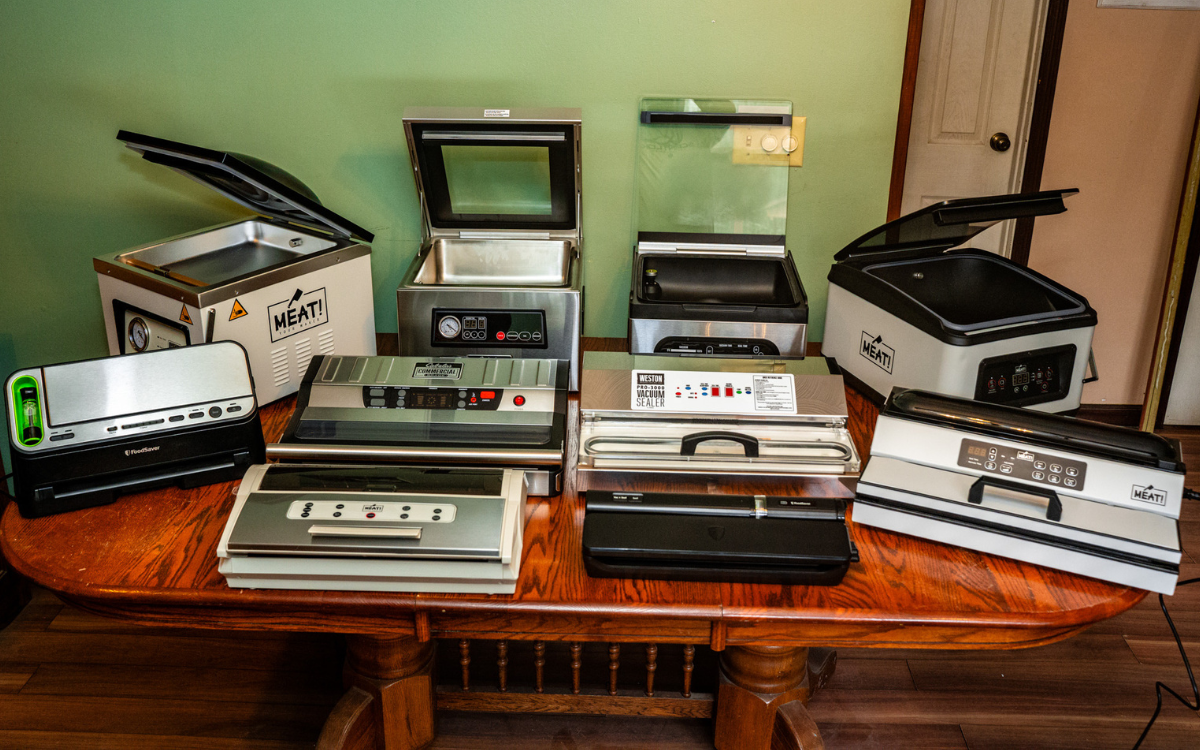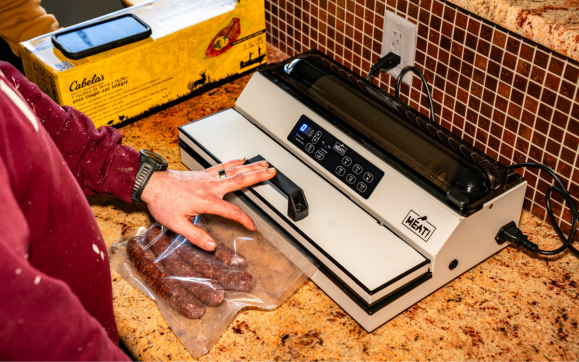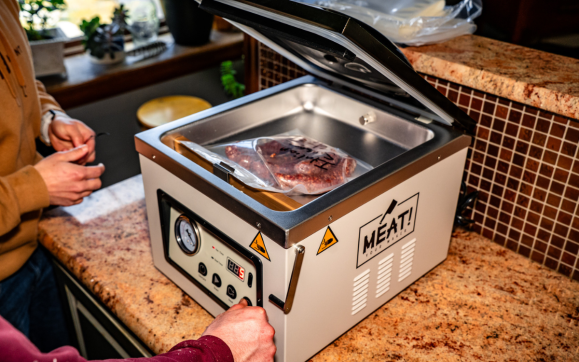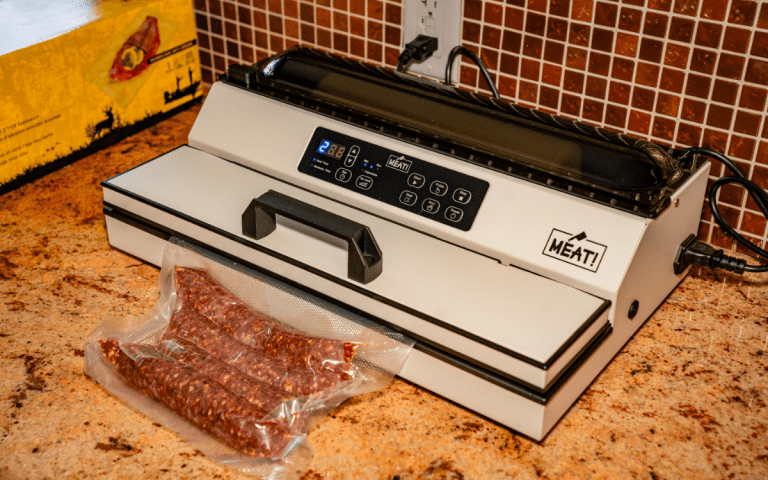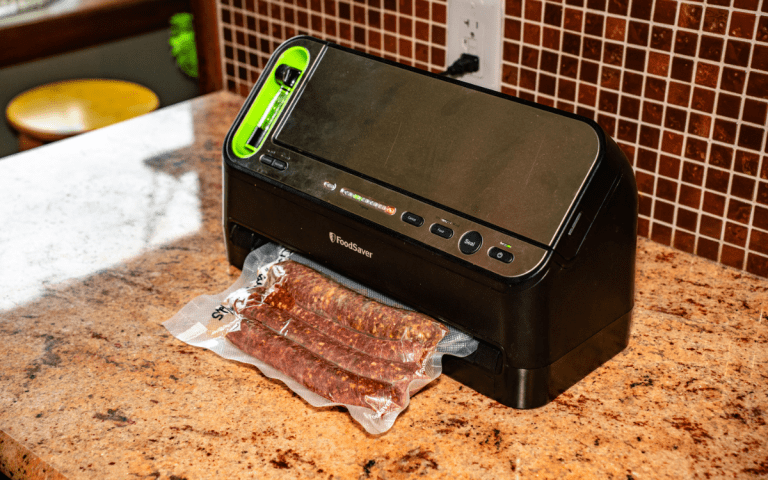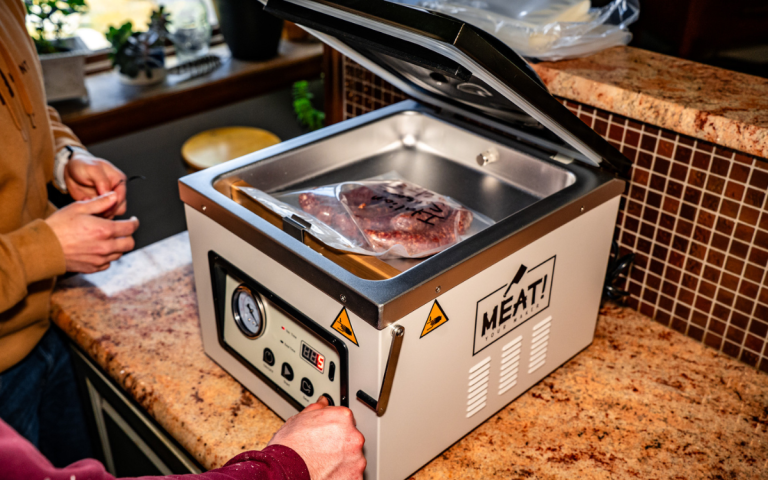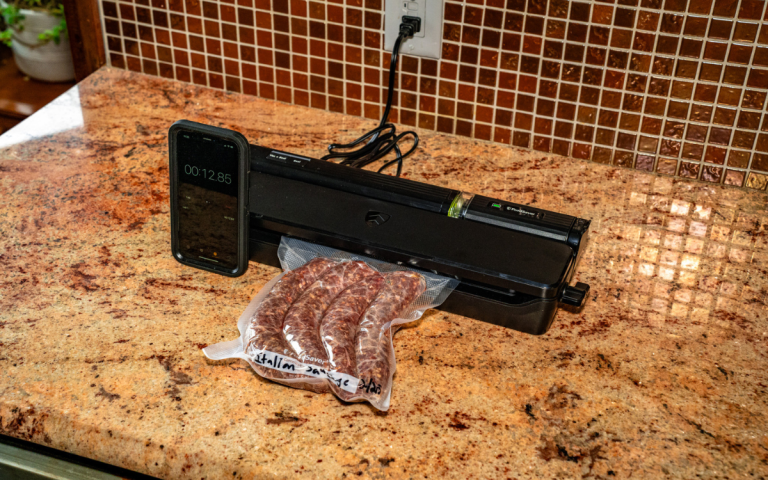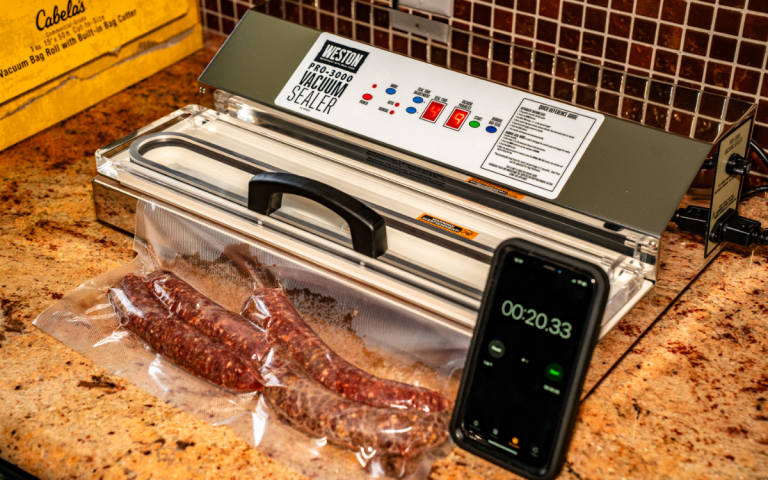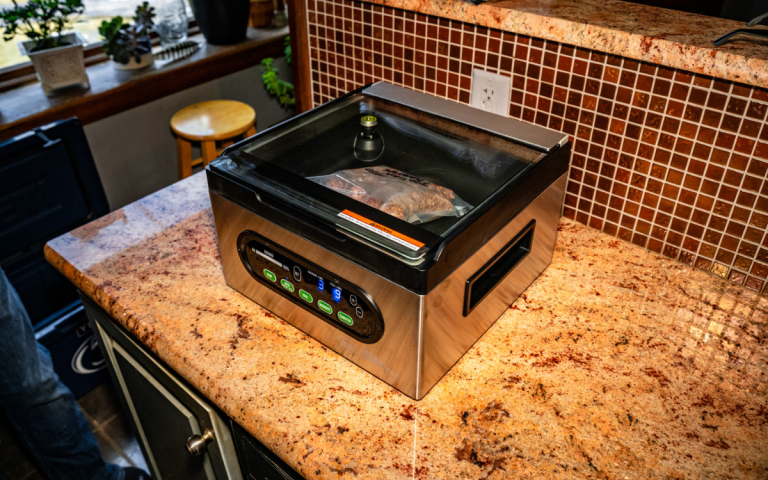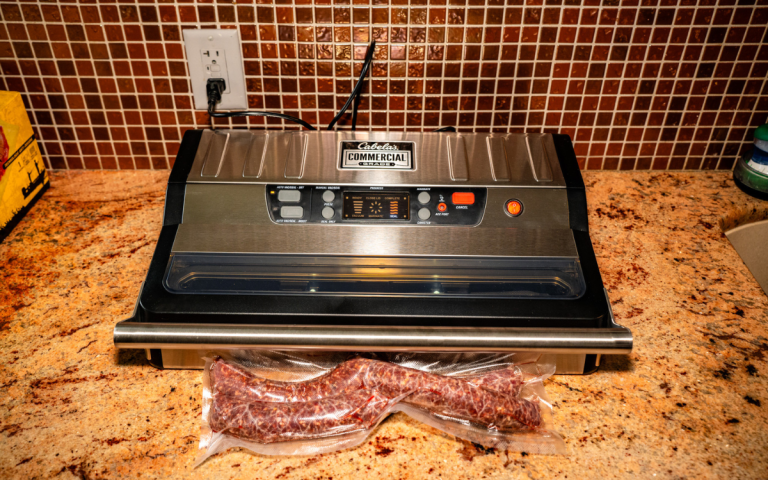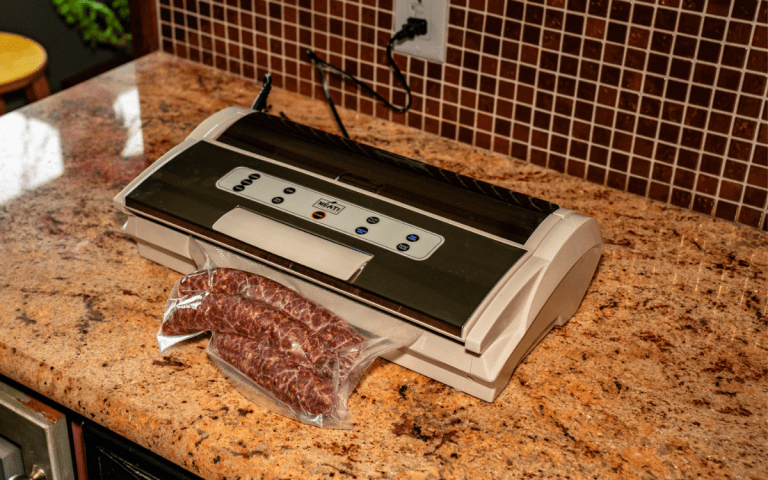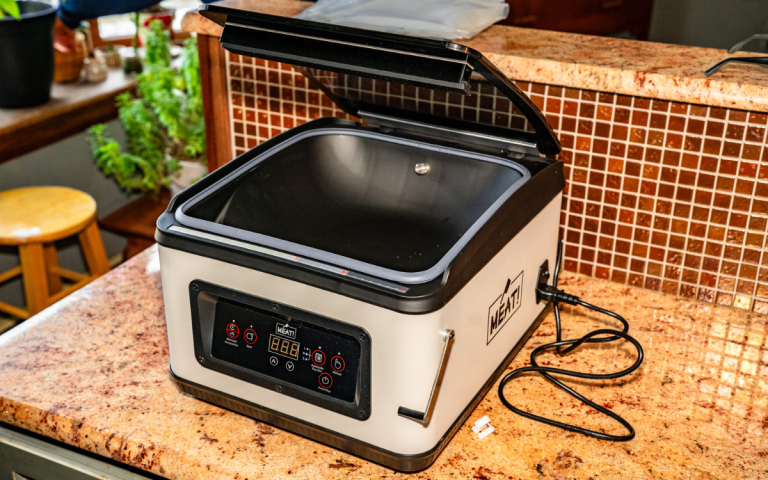We may earn revenue from the products available on this page and participate in affiliate programs. Learn More ›
For more than a decade, my cousin and I have processed all of our deer. Rather than paying upwards of $100 to take it to a butcher to receive pre-packaged meat with no guarantee it was from our own deer, we bought our own knife kit, a cheap vacuum sealer which burned out quickly, and meat grinder and got to work.
Three years ago, we decided to dive into making our own venison sausages in the form of hot dogs, kielbasa, and Italian sausages all over the course of one weekend.
Last year, we acquired five of the best sausage stuffers available and put them to the test. Frankly, it was our best year yet in regard to the quality of our sausages. But, at the end of the weekend as we packaged up all of our meats, we noted that simply throwing them in Ziploc bags would probably lead to freezer burn (we were correct).
This year we decided to test the best vacuum sealers. Here are my picks for the best vacuum sealers after processing and sealing 172 pounds of meat.
- Best Overall External Vac Sealer: Meat! 16” External Vac Sealer
- Best for Home Use: FoodSaver V4400 2-in-1 Vacuum Sealer
- Best Overall Chamber Vac Sealer: MEAT! Chamber Vacuum Sealer with 12″ Sealing Bar
- Best Budget: FoodSaver Handheld+ 2-in-1 Vacuum Sealing System
- Great Buy External Vac Sealer: Weston Pro-3000 Vacuum Sealer
- Great Buy Chamber Vac Sealer: LEM MaxVac Pro Chamber Sealer
- Cabela’s 15” Commercial-Grade Vacuum Sealer
- MEAT! Pro External Sealer
- MEAT! Chamber Vacuum Sealer with Oil-less Pump
- Cabela’s Commercial-Grade Chamber Vacuum Sealer
How We Tested the Vacuum Sealers
As we headed into this year’s annual sausage stuffing party, we acquired ten vacuum sealers from top brands in the meat processing industry — six external vacuum sealers and four chamber vacuum sealers.
The plan was simple, take 114 pounds of venison and 58 pounds of pork fat and produce the following:
- 26 pounds of jalapeño cheddar hot dogs
- 26 pounds of bacon swiss hot dogs
- 33 pounds of ring bologna
- 62 pounds of Italian sausage
- 25 pounds of venison bacon
After measuring the 172 pounds of cubed venison and pork fat, we added it to mixing trays with the respective seasonings. The next morning, we made quick work grinding all five trays using a MEAT! .5-horsepower grinder and LEM Big Bite #32 1.5-horsepower grinder. Then, using our favorite sausage stuffer, we started filling casings. After several hours of stuffing casings, the sausages were ready for the smoker. After reaching the desired internal temperatures, we removed the smoked sausages and began the real test.
Read Next: Best Meat Grinders
As we packaged the sausages in vacuum sealer bags, we evaluated each vacuum sealer based on noise level, efficiency, effectiveness, ease of use, and the features it offers. To determine efficiency we timed the initial seals and the overall vacuum plus seal times on each vacuum sealer 10 times. The times were then averaged to provide you with a clear look at the operating speed for each sealer. To determine effectiveness, each bag’s seal was thoroughly tested to ensure there were no flaws present that could let air in and lead to freezer burn. After a full day of testing, here are our top picks for the best vacuum sealers.
Best Overall External Vacuum Sealer: MEAT! 16” External Vac Sealer
Pros
- Quiet
- Easy to use
- Beeps when finishing the initial seal
- Lid raises and beeps when completing final seal
Cons
- No cord storage
- Lid requires a bit of downward pressure to get the sealing process started
Key Features
- Control panel provides a variety of options, including a timer that allows you to select the precise vacuum sealing duration based on the type of food you are preserving
- Has a bag holder and bag cutter
- Bag cutter clamps down to lock in place
- Equipped with an internal cooling fan to prevent overheating during extended usage
- 16” sealing bar
- Average Initial Seal Time: 10.6 seconds
- Average Vacuum Seal Time: 18.7 seconds
- Dimensions: 21.8” L x 14.1” W x 8” H
- Weight: 15.85 pounds
- Price: $309.99
The MEAT! 16” External Vac Sealer checks almost every box for what I wanted in an external vacuum sealer. With the hundreds of pounds of meat that I seal every year, I always wanted an option that allowed me to use bigger, wider bags. The 16-inch sealing bar does just that, and it does it very well, and very quickly.
With an average initial bag seal time of 10.6 seconds and an average overall vacuum seal and bag seal time of 18.7 seconds, it’s one of the fastest external sealers we tested. After all the testing was completed, we still had to vacuum seal 25-pounds of venison bacon later that evening, and this was the sealer I reached for to get the job done quickly.

The only big negative with this vacuum sealer is that the lid requires a bit of pressure to get the sealing started. Caleb Meighen
I have only two quibbles with this sealer. First, it doesn’t have a place to store the power cord and second the lid requires a little extra encouragement to get the vacuum sealing started. However every other feature of this vacuum sealer is well thought out and functions wonderfully. The bag storage and cutting mechanism is in a great spot to be accessible yet out of the way, and the control panel is intuitive to dive into sealing right out of the box.
We tested each bag that was sealed for flaws or broken seals, and not once did we have a bag that needed re-sealed or one that had too much air left in it. The MEAT! 16” External Vacuum Sealer was by far and away a standout in our field of external sealers. What it lacks in compact storage capabilities, it more than makes up for with vacuum sealing power.
Best for Home Use: FoodSaver V4400 2-in-1 Vacuum Sealer
Pros
- Quiet
- Easy to use
- Compact
Cons
- No cord storage
- Requires extra bag space to fit into the sealing portion of the machine
Key Features
- Control panel provides easy to use options, including a dry/moist option, a cancel option, a seal option, and a power option
- Has accessory option for marinating or usage with vacuum zipper bags and containers
- Has a bag holder and bag cutter
- Automatic bag detection
- LED indicator lights
- 11” sealing bar
- Average Initial Seal Time: 14.8 seconds
- Average Vacuum Seal Time: 23.7 seconds
- Dimensions: 11” L x 20” W x 12” H
- Weight: 10 pounds
- Price: $199.49
Prior to this test, the FoodSaver V4400 2-in-1 Vacuum Sealer was my personal favorite vacuum sealer. I purchased this model a few years ago and have sealed everything from fresh caught lake trout and striper, to whole chickens, to every cut of deer meat imaginable. It’s always done a great job while being quiet enough to run late at night and not wake up the whole house. It’s also compact enough to slide onto a shelf in my kitchen for easy, close-by storage.
With an average initial bag seal time of 14.8 seconds and an average overall vacuum seal and bag seal time of 23.7 seconds, it’s quick enough to use when the meat starts to stack up. Over the years of usage, I’ve noticed that it does require a decent amount of extra bag to slide into the sealer, leaving your vac seal bags with a lot of empty space once they’re sealed up.
While that might not sound like the worst thing in the world, as an overfiller, there’ve been plenty of times where I can’t get the V4400 to provide a good seal and vacuum, causing me to stop, reset, and try again. When you’re sealing hundreds of bags of sausages or other meats, slowing down can really wear on you mentally.
Overall, if you’re a casual outdoorsman or gardener looking for a way to vacuum seal the day’s harvest without sacrificing a ton of shelf space in the kitchen cabinet, the FoodSaver V4400 2-in-1 Vacuum Sealer would be my recommendation to you. If you’re looking for something more heavy duty that’ll withstand hours and hours of continuous usage, perhaps a larger external vacuum sealer would be a better choice.
Best Chamber Vacuum Sealer: MEAT! Chamber Vacuum Sealer with 12″ Sealing Bar
Pros
- Quiet
- Beeps when finished with vacuum sealing
- Simple operation
- Smooth lid
- Great air removal and seal
Cons
- Oil pump design requires proper maintenance over time
Key Features
- Comes equipped with an adjustable seal time, adjustable vacuum, pressure gauge, and digital time readout.
- Bag holder clamps down to lock in place
- 12” sealing bar
- Adjustable Vacuum Time: 5-90 seconds
- Adjustable Seal Time: 0-6 seconds
- Chamber Dimensions: 13” L x 12.2” W x 3.9” H
- Exterior Dimensions: 21.9” L x 19.4” W x 19” H
- Weight: 63.2 pounds
- Price: $839.99
The MEAT! Chamber Vacuum Sealer with 12″ Sealing Bar was my first foray into chamber vacuum sealers, and to say it was impressive would be an understatement. It’s incredibly quiet for how large it is, and the vacuum and seal it puts on each bag is unmatched.
We found the best setting for seal time was 4 seconds and the best vacuum time was 35 seconds. This allowed us to keep sealing bags quickly, but also gave the chamber vacuum enough time to build pressure and really provide an amazing, airtight vacuum and seal.
This model, unlike other chamber vacuums in the test, does have an oil pump design, which means it does require proper maintenance to keep it running to its full potential. It comes with instructions and everything you’ll need to know to perform the maintenance, and shouldn’t take more than a minute or two.
What really set this chamber vacuum sealer apart from the others in the test was how well it sealed each bag, and how quietly it did so. The other chamber vacuums were loud, almost obnoxiously so, but not the MEAT! Chamber Vacuum Sealer. While it has a hefty price tag, if you’re looking for a chamber vacuum sealer for both meats, vegetables, and liquids like soups, it’s worth the extra money to get the quietest, and best performing chamber vacuum we tested.
Best Budget: FoodSaver Handheld+ 2-in-1 Vacuum Sealing System
Pros
- Quiet
- Easy to use
- Compact
- Lightweight
- Cordless handheld unit
Cons
- No cord storage
- No bag holder or cutter
- Requires pre-cut bags
- No indication when sealing is completed
Key Features
- Control panel provides easy to use options, including a vac/seal option and a seal option
- Has handheld accessory option with rechargeable battery for marinating or usage with vacuum zipper bags and containers
- 11” sealing bar
- Average Initial Seal Time: 16.5 seconds
- Average Vacuum Seal Time: 37.7 seconds
- Dimensions: 6.6” L x 17.8” W x 3.4” H
- Weight: 6.3 pounds
- Price: $149.99
The FoodSaver Handheld+ 2-in-1 Vacuum Sealing System is the smallest, lightest, and cheapest vacuum sealer we tested. With that, this unit is light on features. The lack of a bag holder or cutter is my biggest concern. While brands like FoodSaver and others sell pre-cut bags, for most of my vacuum sealing, I’m purposefully measuring and cutting a bag that will meet my needs for the given cut of meat.
Aside from needing pre-cut bags, this vacuum sealer performed admirably well. With an average initial bag seal time of 16.5 seconds and an average overall vacuum seal and bag seal time of 37.7 seconds, it was on par with most of the external sealers in the test in regard to speed.
As for the quality of the seal, we ran into a few bags that needed re-sealed throughout our testing. While that’s not the worst thing in the world if you catch it, it’s worth noting that if you choose to purchase this vacuum sealer, you’ll want to check each seal before putting the bags in the freezer. Overall, I was happy with how well this vacuum sealer performed given its cost. It’s a viable option for those looking to get into the vacuum sealing game.
External Vacuum Sealer Great Buy: Weston Pro-3000 Vacuum Sealer
Pros
- Internal storage for power cord
- Fastest sealer in the test
- Clicks and lid raises when completing final seal
Cons
- No bag holder or cutter
- Requires pre-cut bags
- Control panel not intuitive, read owners manual prior to sealing
Key Features
- Digital control panel provides a variety of options, including a timer that allows you to select the precise bag sealing duration and vacuum sealing duration based on the type of food you are preserving
- Equipped with an internal cooling fan to prevent overheating during extended usage
- 15” sealing bar
- Average Initial Seal Time: 6.5 seconds
- Average Vacuum Seal Time: 21.4 seconds
- Dimensions: 19.1” L x 12.3” W x 6” H
- Weight: 27 pounds
- Price: $529.99
The Weston Pro-3000 Vacuum Sealer made a run for the best overall external chamber vacuum sealer throughout our testing. It’s by far the fastest sealer in the test, and during our bag checks, it never had a seal failure. It boasts a wide 15-inch sealing bar and digital control panel that allows you to program the sealer to the exact settings you prefer.
But, I was quite disappointed to find that the Pro-3000 did not have a bag holder or cutter, and the control panel wasn’t very intuitive right out of the box. It was the only sealer in the test that required a quick overview of the manual prior to proper usage.
As for speed, with an average initial bag seal time of 6.5 seconds and an average overall vacuum seal and bag seal time of 21.4 seconds, we were blown away by how quickly the Pro-3000 was able to create a quality vacuum and seal. If not for the lacking additional features, this vacuum sealer would have been a no-brainer for best overall. But still, it’s a great buy for those who are fine with pre-cut bags.
Chamber Vacuum Great Buy: LEM MaxVac Pro Chamber Sealer
Pros
- Clicks when vacuum sealing begins
- Simple operation
- Smooth lid
- Great air removal and seal
- Lightweight in comparison
- Oil-less pump
Cons
- No noise when sealing is finished
- Loud
Key Features
- Comes equipped with an adjustable seal time, adjustable vacuum, a maintenance free oil-less pump, and digital pressure gauge
- Auto-mode for vacuum and seal
- Lock bar to hold bag in place
- 11.42″ seal bar makes dual 2.5mm seals
- Adjustable Vacuum Time: 15-60 seconds
- Adjustable Seal Time: 3-9 seconds
- Chamber Dimensions: 11.24″ L x 11.81″ W x 3.93″ H
- Exterior Dimensions: 13.9″ L x 14.29″ W x 8.58″ H
- Weight: 22.5 pounds
- Price: $499.99
The LEM MaxVac Pro Chamber Sealer was another standout in the field of chamber vacuums we tested. It was easy to operate, provided a quality vacuum and seal, and was lightweight compared to some of the other chamber vacs.
However, it was quite loud. We noted that all of the oil-less models in the test were noisy, and the MaxVac Pro followed that trend. Aside from the noise it made while in operation, one thing we noticed was that it didn’t let us know when it had completed sealing a bag. While many other models beeped or clicked, the MaxVac Pro just went quiet.
Aside from those small complaints, the MaxVac Pro was a breeze to use. The bag holder worked great to keep the bag from sliding down into the chamber, and the adjustable times were quite intuitive. In our post vacuum and sealing tests, we never had a seal failure and each bag was air tight. I was very excited by how the LEM MaxVac Pro Chamber Sealer performed and believe it’s a great buy for those looking for an oil-less chamber vacuum.
Cabela’s 15” Commercial-Grade Vacuum Sealer
Pros
- Quiet
- Easy to use
- Beeps when finishing the initial seal
- Lets you know when the lid is closed
- LCDs allow you to track vacuum sealing progress
Cons
- External cord storage
- Lock-down handle was finicky at times
Key Features
- Large digital LCD information center with easy-touch control-panel buttons
- Has a bag holder and bag cutter
- Lock-down handle
- Equipped with an internal cooling fan to prevent overheating during extended usage
- 15” sealing bar
- Average Initial Seal Time: 19.8 seconds
- Average Vacuum Seal Time: 32.5 seconds
- Dimensions: 14.75” L x 19.75” W x 5.44” H
- Weight: 14.75 pounds
- Price: $399.99
The Cabela’s 15” Commercial-Grade Vacuum Sealer was another impressive addition to our test. Staying in line with offering the capabilities for larger bags to be used, this Cabela’s sealer provides a quality vacuum and seal on each bag. The control panel has a lot going on, but is still fairly intuitive right out of the box, allowing us to easily set and control the vacuum sealer.
With an average initial bag seal time of 19.8 seconds and an average overall vacuum seal and bag seal time of 32.5 seconds, it wasn’t the speediest vacuum sealer we tested, but it did a nice job. One thing I really liked about the Cabela’s 15” Commercial-Grade Vacuum Sealer was the ability to track the progress of the vacuum and seal through the LCDs on the control panel. It also audibly beeps when each vacuum and seal is finished so you don’t try to remove the bag too early.
One of the only hiccups was the lock-down handle gave us fits a few times. There was a lot of play in the handle, making it tough to know whether or not it was fully closed at times. Although, with a little extra push, it seemed to function properly.
As with most of Cabela’s offerings in the meat processing field, their vacuum sealer was high quality, and performed well. We only had one seal failure during our testing, and we believe that may have been due to an abundance of moisture in the bag.
MEAT! Pro External Sealer
Pros
- Easy to use
- Beeps three times when finishing the seal
- Light up buttons
- Lightweight
Cons
- Loud
- No cord storage
- Experienced some difficulty closing lid and engaging sealing function at the same time
Key Features
- Control panel features adjustable seal time, adjustable vacuum, pressure gauge, and digital time display
- Has a bag holder and bag cutter
- Removable drip tray
- Equipped with an internal cooling fan to prevent overheating during extended usage
- 14” sealing bar
- Average Initial Seal Time: 15.6 seconds
- Average Vacuum Seal Time: 27.8 seconds
- Dimensions: 17.8” L x 9.5” W x 4.8” H
- Weight: 6.4 pounds
- Price: $199.99
The MEAT! Pro External Sealer didn’t blow us away the way that other external vacuum sealers did. It was fairly loud when vacuuming and sealing, and we ran into some issues with closing the lid and engaging the vac/seal function at the same time.
On the upside, the control panel was incredibly intuitive and easy to use right out of the box, it has a built-in bag holder and cutting mechanism which is a big plus in my book, and it audibly beeps three times when finishing the seal. With an average initial bag seal time of 15.6 seconds and an average overall vacuum seal and bag seal time of 27.8 seconds, it was middle of the pack in regard to speed, but in our bag checks, we never came across a failed seal.
It’s also one of the more lightweight options as well as one of the easiest to store. For the price point and features included, the MEAT! Pro External sealer is a great value buy for someone looking for a feature rich and effective vacuum sealer.
MEAT! Chamber Vacuum Sealer with Oil-less Pump
Pros
- Simple operation
- Smooth lid
- Great air removal and seal
- Oil-less pump
Cons
- Bowl-like chamber is slightly smaller than some other chamber vac sealers
- Loud
Key Features
- Includes vacuum bag sampler pack
- 12-inch sealing bar
- Digital vacuum and seal time display
- Auto bag size select feature
- Adjustable Vacuum Time: 5-80 seconds
- Adjustable Seal Time: 0-9 seconds
- Chamber Dimensions: 13” L x 12.2” W x 3.5” H
- Exterior Dimensions: 17.5” L x 14” W x 10.25” H
- Weight: 29 pounds
- Price: $709.99
The MEAT! Chamber Vacuum Sealer with Oil-less Pump was by far and away the loudest chamber vacuum sealer we tested. With that said, it was also one of the most effective. It’s incredibly intuitive and easy to use control panels led to a great vacuum and seal on the bags, and I was very impressed with the auto bag size selector. It made it easy to just drop the bag in and let the chamber vacuum do its thing.
In manual mode, we had to play around with the seal time to ensure a good seal. We found that 7 seconds was the sweet spot. While the chamber doesn’t have a lock bar to keep the bag in place, we never had an issue with the bag sliding down during the vacuum sealing process.
Overall, aside from how loud this oil-less chamber vacuum sealer was, I was very pleased with how well it performed. Once we dialed in the timing in manual mode, our seals were strong and the bags were airtight. Coming in at a lower price point from the other MEAT! chamber vacuum in the test, the MEAT! Chamber Vacuum Sealer with Oil-less Pump is a great buy for someone looking for a quality chamber vac at a more affordable price point.
Cabela’s Commercial-Grade Chamber Vacuum Sealer
Pros
- Simple operation
- Smooth lid
- Audible pressure release when finished vacuum sealing
- Magnetic lock bar to secure bags in chamber
- Oil-less pump
- Built-in power cord wrap
Cons
- Loud
Key Features
- 1-touch auto vac and seal function
- Pressure gauge
- 12-inch sealing bar
- Adjustable Vacuum Time: 20-99 seconds
- Adjustable Seal Time: 3-9 seconds
- Chamber Dimensions: 12” L x 11.5” W x 3.5” H
- Exterior Dimensions: 16.5” L x 14.5” W x 9.5” H
- Weight: 30 pounds
- Price: $599.99
The Cabela’s Commercial-Grade Chamber Vacuum Sealer rounds out our chamber vacuum sealers in the test, and honestly, it was right up with the others in regard to performance. I really enjoyed the magnetic lock bar that secures the bags in the chamber, and the pressure gauge was a nice addition to monitor the vacuum levels as the machine was running.
Similar to the other oil-less pumps in the test, it was quite loud to run indoors. Aside from being loud, it still performed wonderfully. It was very easy to operate right out of the box and the double-sealing bar is a great feature.
I was impressed with the one-touch auto vac and seal function as well, although we did have an issue with one of the bags not properly sealing, despite the double seal. We’re unsure why, as every other bag was sealed to perfection. Overall, the Cabela’s Commercial-Grade Chamber Vacuum Sealer performed as expected and provided an airtight seal on 99% of the bags we put into it. It’s a great option and an even better pricepoint for those looking at chamber vacuums.
How to Choose the Best Vacuum Sealer

Chamber vs. External Vacuum Sealer
An external vacuum sealer, like the FoodSaver options in this review, sucks air out of the front of the bag and then seals it. A chamber sealer equalizes the pressure inside the bag and in the chamber. That key difference is why chamber sealers are better options for sealing liquids like soups and marinades. The liquid doesn’t get sucked out of the bag and interfere with the seal. Chamber sealers can also be used for vacuuming canning jars. Another major difference is that chamber sealers can use less expensive bags than external vacuum sealers.
How You’ll Use Your Vacuum Sealer
Every outdoorsman needs a quality vacuum sealer, but not everyone is going to have the same demands. If you need a model that you can take to your fishing camp, then a portable, minimalist model is ideal. If you’re preserving a lot of food, including liquids, then a chamber sealer is a worthwhile investment.
Vacuum Sealing Tips
- Double seal your bags
- Be gentle with vacuum-sealed food, so you don’t break the seal
- Don’t forget to label your bags
FAQs
Vacuum sealers are one of the handiest kitchen tools because they reduce food waste and speed up marinating times.
External and chamber vacuum sealers are the two main types. External vacuum sealers are ideal for most use cases, but chamber sealers are excellent for high-volume use and liquids.
FoodSaver, Uline, OutOfAir, Kirkland, and Cabela’s all make great vacuum bags. The key is buying in bulk to save money and to make sure you buy the right type for your sealer.
Final Thoughts on the Best Vacuum Sealers
We tested a lot of vacuum sealers during our ‘Sausage Party’ and came out of testing with some favorites, and I was thoroughly impressed with the field in general. I can genuinely say that I’d be happy to run any of these vacuum sealers as my “daily driver,” which I was not expecting to be the case.
In the end, the additional features are nice, but the quality of the seal is the key to preserving your hard earned game, catch, or harvest. Every sealer in this story provides a great seal that will allow you to keep your food frozen safely for years to come. If you haven’t started vacuum sealing your food yet, quit waiting around and dealing with freezer burn, save time and money with the best vacuum sealers.
- Best Overall External Vac Sealer: Meat! 16” External Vac Sealer
- Best for Home Usage: FoodSaver V4400 2-in-1 Vacuum Sealer
- Best Overall Chamber Vac Sealer: MEAT! Chamber Vacuum Sealer with 12″ Sealing Bar
- Best Budget: FoodSaver Handheld+ 2-in-1 Vacuum Sealing System
- Great Buy External Vac Sealer: Weston Pro-3000 Vacuum Sealer
- Great Buy Chamber Vac Sealer: LEM MaxVac Pro Chamber Sealer
- Cabela’s 15” Commercial-Grade Vacuum Sealer
- MEAT! Pro External Sealer
- MEAT! Chamber Vacuum Sealer with Oil-less Pump
- Cabela’s Commercial-Grade Chamber Vacuum Sealer
